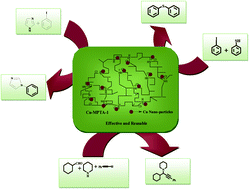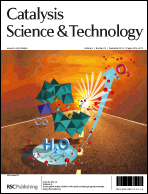Cu-grafted mesoporous organic polymer: a new recyclable nanocatalyst for multi-component, N-arylation and S-arylation reactions†
Abstract
A new mesoporous Cu-MPTA-1 nanocatalyst has been synthesized via a simple and facile in situ radical polymerization of triallylamine in the presence of an organic–organic self-assembly of anionic surfactant SDS, followed by grafting of Cu(II) at room temperature under an inert atmosphere. This nanomaterial has been characterized by elemental analysis, powder X-ray diffraction (XRD), transmission electron microscopy (TEM), Fourier transform infrared spectroscopy (FT-IR), UV–vis diffuse reflectance spectroscopy (DRS), thermogravimetric analysis (TGA), N2 adsorption–desorption studies, X-ray photoelectron spectroscopy (XPS) and EPR spectroscopy. Cu-MPTA-1 acts as an efficient heterogeneous nanocatalyst exhibiting a high catalytic activity for N-arylation and S-arylation reactions using water as a green solvent and also exhibits an excellent catalytic activity for the one-pot synthesis of propargylamines via a three component coupling of an alkyne, an amine and an aldehyde at room temperature. Moreover, the catalyst is easily recoverable and can be reused six times without an appreciable loss of catalytic activity in the three component coupling reaction. The highly dispersed Cu(II) sites in the Cu-grafted mesoporous polymer could be responsible for the observed high activities of the Cu-MPTA-1 catalyst in the coupling reactions. No evidence of leached Cu from the catalyst during the course of the reaction has been observed, suggesting true heterogeneity in the catalytic process.


 Please wait while we load your content...
Please wait while we load your content...